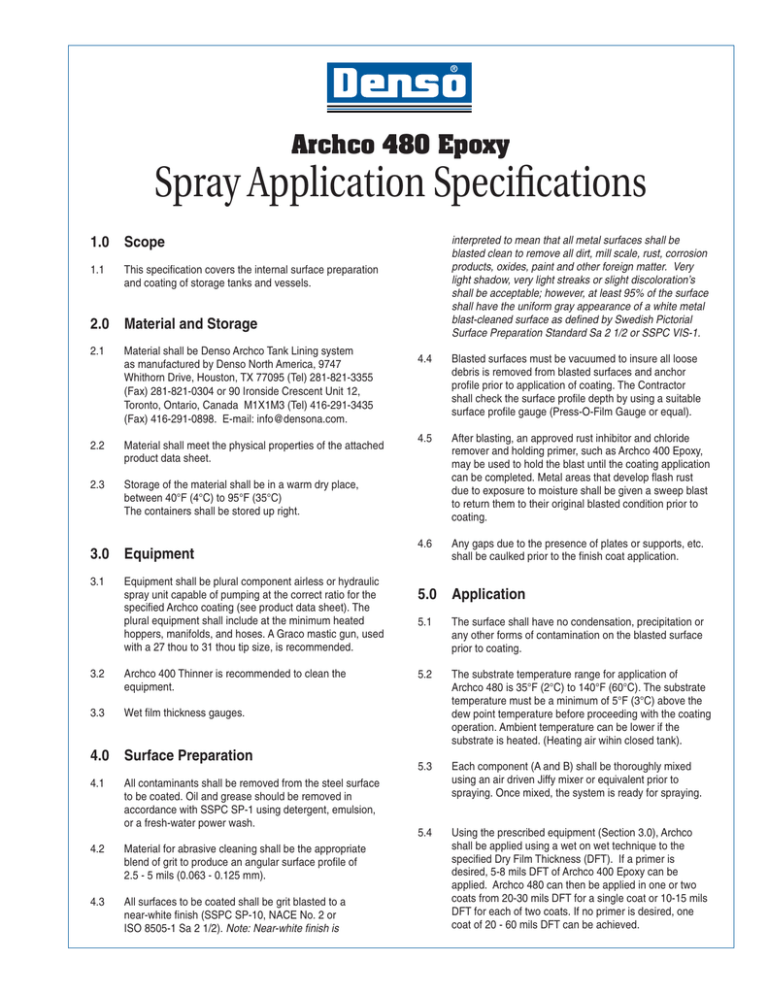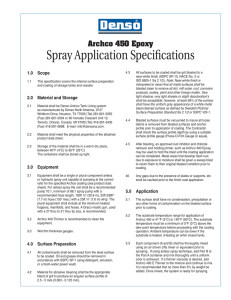Denso Archco 480 Spray Application Spec
advertisement

Archco 480 Epoxy Spray Application Specifications interpreted to mean that all metal surfaces shall be blasted clean to remove all dirt, mill scale, rust, corrosion products, oxides, paint and other foreign matter. Very light shadow, very light streaks or slight discoloration’s shall be acceptable; however, at least 95% of the surface shall have the uniform gray appearance of a white metal blast-cleaned surface as defined by Swedish Pictorial Surface Preparation Standard Sa 2 1/2 or SSPC VIS-1. 1.0 Scope 1.1 This specification covers the internal surface preparation and coating of storage tanks and vessels. 2.0 Material and Storage 2.1 Material shall be Denso Archco Tank Lining system as manufactured by Denso North America, 9747 Whithorn Drive, Houston, TX 77095 (Tel) 281-821-3355 (Fax) 281-821-0304 or 90 Ironside Crescent Unit 12, Toronto, Ontario, Canada M1X1M3 (Tel) 416-291-3435 (Fax) 416-291-0898. E-mail: info@densona.com. 2.2 Material shall meet the physical properties of the attached product data sheet. 2.3 Storage of the material shall be in a warm dry place, between 40°F (4°C) to 95°F (35°C) The containers shall be stored up right. 3.0 Equipment 3.1 Equipment shall be plural component airless or hydraulic spray unit capable of pumping at the correct ratio for the specified Archco coating (see product data sheet). The plural equipment shall include at the minimum heated hoppers, manifolds, and hoses. A Graco mastic gun, used with a 27 thou to 31 thou tip size, is recommended. 3.2 Archco 400 Thinner is recommended to clean the equipment. 3.3 Wet film thickness gauges. 4.0 Surface Preparation 4.1 All contaminants shall be removed from the steel surface to be coated. Oil and grease should be removed in accordance with SSPC SP-1 using detergent, emulsion, or a fresh-water power wash. 4.2 Material for abrasive cleaning shall be the appropriate blend of grit to produce an angular surface profile of 2.5 - 5 mils (0.063 - 0.125 mm). 4.3 All surfaces to be coated shall be grit blasted to a near-white finish (SSPC SP-10, NACE No. 2 or ISO 8505-1 Sa 2 1/2). Note: Near-white finish is 4.4 Blasted surfaces must be vacuumed to insure all loose debris is removed from blasted surfaces and anchor profile prior to application of coating. The Contractor shall check the surface profile depth by using a suitable surface profile gauge (Press-O-Film Gauge or equal). 4.5 After blasting, an approved rust inhibitor and chloride remover and holding primer, such as Archco 400 Epoxy, may be used to hold the blast until the coating application can be completed. Metal areas that develop flash rust due to exposure to moisture shall be given a sweep blast to return them to their original blasted condition prior to coating. 4.6 Any gaps due to the presence of plates or supports, etc. shall be caulked prior to the finish coat application. 5.0 Application 5.1 The surface shall have no condensation, precipitation or any other forms of contamination on the blasted surface prior to coating. 5.2 The substrate temperature range for application of Archco 480 is 35°F (2°C) to 140°F (60°C). The substrate temperature must be a minimum of 5°F (3°C) above the dew point temperature before proceeding with the coating operation. Ambient temperature can be lower if the substrate is heated. (Heating air wihin closed tank). 5.3 Each component (A and B) shall be thoroughly mixed using an air driven Jiffy mixer or equivalent prior to spraying. Once mixed, the system is ready for spraying. 5.4 Using the prescribed equipment (Section 3.0), Archco shall be applied using a wet on wet technique to the specified Dry Film Thickness (DFT). If a primer is desired, 5-8 mils DFT of Archco 400 Epoxy can be applied. Archco 480 can then be applied in one or two coats from 20-30 mils DFT for a single coat or 10-15 mils DFT for each of two coats. If no primer is desired, one coat of 20 - 60 mils DFT can be achieved. 5.5 The thickness of Archco 480 should be checked continuously by wet film gauge to achieve the minimum / maximum film thickness specified. Notification to the applicator of any inadequately coated sections must be made immediately and repaired. 6.0 Inspection 6.1 The finished coating shall be smooth and of uniform millage with no holidays. All surfaces shall have the required minimum/maximum DFT. In general, the surface of the coating shall be no rougher than the base or substrate material. 6.2 After Archco 480 has cured to a hard cure condition, the owner’s representative and/or contractor’s inspector should measure the film thickness by magnetic gauge and notify the applicator of their acceptance. 6.3 For most applications, tank filling can be accomplished when the coating reaches a Shore D of 70. The “thumb nail test” can also be used. The thumb nail test is defined by when one can no longer make a permanent indention in the coating using one’s thumb nail. 6.4 An acceptable field test to check to see if the coating has a full chemical cure, a solvent such as Xylene, MEK or Toluene can be rubbed on to the coating. If the gloss/ sheen is removed the coating is not fully cured. 6.5 Spark testing shall be performed to ensure proper film thickness and for holiday inspection. The voltage used for testing weld joints and field applications shall be equal to that used for testing the mainline coating in the field or 125 volts/mil. based on the specified min. mil. thickness. 6.6 Denso and/or the owner’s representative immediately upon completion of the work shall make final inspection of the completed application. Notification of all defects must be made within a reasonable time frame from completion of the work to allow for all repairs within the allowed time frame for the project. 6.7 Recoating: If a second coat is required and passes the cure test as described in section 6.3, the surfaces shall be roughened by sweep blasting. If the coating is soft, no surface preparation is required. or by grit blasting prior to application of the coating. All edges of the surrounding area should be feathered prior to performing the repair. 8.0 Safety Precautions 8.1 Follow the guidelines detailed in the Material Safety Data Sheets (MSDS). 8.2 Keep containers closed when not in use. In case of spillage, absorb with inert material and dispose of in accordance with applicable regulations. 8.3 No open flames, smoking or welding will be allowed in the immediate vicinity during the spray application of Archco 480 Epoxy Tank Lining. 8.4 Always refer to project specifications as they may supercede Denso specifications. 7.0 Repairs 7.1 7.2 7.3 VER 1409.24 Pinhole repairs may be repaired by using Archco Repair Cartridge. Areas shall be roughened a minimum 1 in. around holiday using Carborundum cloth or 80 grit sandpaper and wiped clean with a xylene soaked cloth prior to patching. All holidays shall be repaired. Areas larger than 0.15 sq. in. (0.9 sq. cm.), but less than 1.0 sq. ft. (1000 sq. cm.) shall be repaired using a Archco Repair Cartridge. The surface to be coated shall be clean and dry prior to applying the coating. Surfaces shall be pre-heated in accordance with Section 5.2. Areas requiring repair shall be prepared with a surface grinder DENSO NORTH AMERICA HOUSTON: TORONTO: 9747 Whithorn Drive, 90 Ironside Crescent, Houston, Texas, Unit 12, Toronto, U.S.A. 77095 Ontario, Canada M1X1M3 Tel: 281-821-3355 Tel: 416-291-3435 Fax: 281-821-0304 Fax: 416-291-0898 www.densona.com A Member of Winn & Coales International



